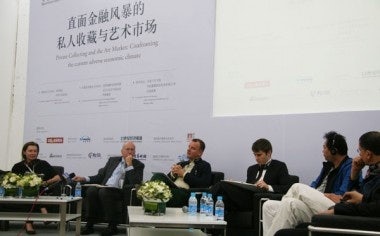Forum Provides Opportunity For Western, Chinese Collectors, Curators And Artists Come Together To Discuss Future Of Art Collecting In China#

Although the last few years have seen the rapid rise of the New Chinese Collector of contemporary Chinese art, the relatively late arrival of Chinese collectors means that the vast majority of major works of contemporary Chinese art remain in the collections of Western art collectors (such as the former Swiss diplomat-turned-prolific collector Uli Sigg, who owns around 2,000 pieces) or Western art museums and galleries. Although buying trends are changing, as more Chinese collectors and curators start to bolster their collections and diversify the artwork they acquire, one of the unique challenges that art lovers in China must face is the dearth of contemporary Chinese artwork available for view in their local museums and galleries.
With these issues -- the underdevelopment of Chinese art museums and the growing interest in private art collection in China -- in mind, this weekend the Global Collecting Forum was held at Beijing's Reignwood Theater. The forum brought together a number of prominent Western and Chinese art collectors, museum curators, gallery owners and artists, whose work was shown at an exhibition which included pieces by prominent Chinese artists like Cai Guoqiang, Xu Bing, Liu Xiaodong and Wang Guangyi.
According to Cultural China:
[Chinese writer-filmmaker Sun Shuyun], who was a guest at last year's ISD forum, has met some of the world's best-known art collectors and museum directors there. But she was somehow left with the impression that many of these "leaders of art collecting actually knew very little about Chinese art."
The situation is expected to improve as this year's forum brings over 30 leading art experts from Europe, the United States and Russia to meet with their Asian counterparts in the Chinese capital. Those set to show up include Baroness Kennedy QC, a trustee of the British Museum; Alexandra Monroe, senior curator at the Guggenheim Museum; and Derek Gillman, director of the US-based Barnes Foundation, a top collector of Post-Impressionist paintings.
After the activity of recent weeks, when more events such as this were held during China's celebratory "Golden Week" and during the Songzhuang Art Festival (where China's first-ever conference of collectors of Chinese contemporary art took place), it is clear that new Chinese collectors (and curators) are motivated to gain more artistic literacy while also learning techniques for boosting public awareness and interest in Chinese contemporary art. From an analysis of the Global Collecting Forum on China.org:
"Major museums in China are still focused largely on modern art as opposed to contemporary... and their collections rely largely on donations from artists or their relations," [Wang Huangsheng, director of the Art Museum of China Central Academy of Fine Arts] said recently at the Global Collecting Forum, which for the first time gathered the world's top institutional and private collectors in Beijing. According to Wang, although some museums have agendas for contemporary art, a small budget and an incomplete art preservation system are two major obstacles for Chinese museums in acquiring contemporary art. Wang calls on Chinese art museums to expand their financial resources, and make long-term and systematic collecting agendas.
...
Experts at the forum believe it's the responsibility of art museums and institutions to help the general public understand contemporary art, and by cultivating a wider social interest, motivate the public to become collectors.
Uli Sigg, the Swiss collector of Chinese contemporary art, has said he will probably bring his collection back to China eventually. ("In the end, it would make sense for the Chinese people to see their own art.") Hopefully by then, Chinese museums and private collectors will be ready to include those artworks in their permanent collections.